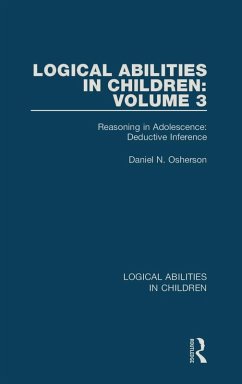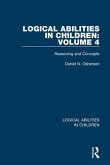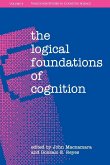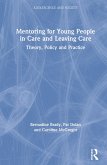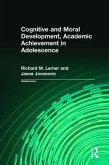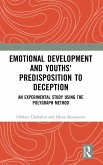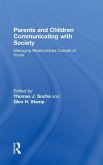Daniel N Osherson
Logical Abilities in Children: Volume 3
Reasoning in Adolescence: Deductive Inference
Daniel N Osherson
Logical Abilities in Children: Volume 3
Reasoning in Adolescence: Deductive Inference
- Gebundenes Buch
- Merkliste
- Auf die Merkliste
- Bewerten Bewerten
- Teilen
- Produkt teilen
- Produkterinnerung
- Produkterinnerung
Originally published in 1975, this volume (3 of 4) presents an expanded model of certain deductive abilities in children and adults.
Andere Kunden interessierten sich auch für
![Logical Abilities in Children: Volume 4 Logical Abilities in Children: Volume 4]() Daniel N OshersonLogical Abilities in Children: Volume 4160,99 €
Daniel N OshersonLogical Abilities in Children: Volume 4160,99 €![The Logical Foundations of Cognition The Logical Foundations of Cognition]() John Macnamara / Gonzalo E. ReyesThe Logical Foundations of Cognition76,99 €
John Macnamara / Gonzalo E. ReyesThe Logical Foundations of Cognition76,99 €![Intelligence and Human Abilities Intelligence and Human Abilities]() Colin CooperIntelligence and Human Abilities209,99 €
Colin CooperIntelligence and Human Abilities209,99 €![Mentoring for Young People in Care and Leaving Care Mentoring for Young People in Care and Leaving Care]() Bernadine BradyMentoring for Young People in Care and Leaving Care157,99 €
Bernadine BradyMentoring for Young People in Care and Leaving Care157,99 €![Cognitive and Moral Development, Academic Achievement in Adolescence Cognitive and Moral Development, Academic Achievement in Adolescence]() Richard M LernerCognitive and Moral Development, Academic Achievement in Adolescence187,99 €
Richard M LernerCognitive and Moral Development, Academic Achievement in Adolescence187,99 €![Emotional Development and Youths' Predisposition to Deception Emotional Development and Youths' Predisposition to Deception]() Oleksiy ChebykinEmotional Development and Youths' Predisposition to Deception162,99 €
Oleksiy ChebykinEmotional Development and Youths' Predisposition to Deception162,99 €![Parents and Children Communicating with Society Parents and Children Communicating with Society]() Parents and Children Communicating with Society163,99 €
Parents and Children Communicating with Society163,99 €-
-
-
Originally published in 1975, this volume (3 of 4) presents an expanded model of certain deductive abilities in children and adults.
Produktdetails
- Produktdetails
- Verlag: Taylor & Francis
- Seitenzahl: 282
- Erscheinungstermin: 14. August 2017
- Englisch
- Abmessung: 234mm x 156mm x 18mm
- Gewicht: 581g
- ISBN-13: 9781138087170
- ISBN-10: 1138087173
- Artikelnr.: 69943243
- Herstellerkennzeichnung
- Libri GmbH
- Europaallee 1
- 36244 Bad Hersfeld
- gpsr@libri.de
- Verlag: Taylor & Francis
- Seitenzahl: 282
- Erscheinungstermin: 14. August 2017
- Englisch
- Abmessung: 234mm x 156mm x 18mm
- Gewicht: 581g
- ISBN-13: 9781138087170
- ISBN-10: 1138087173
- Artikelnr.: 69943243
- Herstellerkennzeichnung
- Libri GmbH
- Europaallee 1
- 36244 Bad Hersfeld
- gpsr@libri.de
Daniel N. Osherson
Preface. Part 1: Introduction 1. Developmental Issues 2. The Research
Question Sharpened 3. Three Kinds of Models for Logical Judgment 4.
Deduction Models: General Considerations and an Exemplification 5.
Empirical Conditions on Derivations 6. Methodological Issues 7. Method
Part 2: Propositional Arguments 8. Experiment 1: Validation of Methodology,
and the Question of Alternative Operations 9. Experiment 2: Within-Subject
Consistency and Complex, Single-Operation Arguments 10. Experiment 3: New
Operations 11. Experiment 4: Amalgamation of the Two Sets of Operations 12.
Experiment 5: Further Test of the Theory Part 3: Familiar Content and Class
Inclusion 13. The Question of a Qualitative Difference Reexamined 14.
Experiment 6: Causal Arguments Testing the Theory of Table 8.1 15.
Experiment 7: Causal Arguments Testing the Theory of Table 11.1 16.
Experiment 8: More Causal Arguments Testing the Theory of Table 11.1 17.
Experiment 9: Class-Inclusion Arguments Testing the Theory of Table 8.1 18.
Experiment 10: Class-Inclusion Arguments Testing the Theory of Table 11.1
19. Experiment 11: More Class-Inclusion Arguments Testing the Theory of
Table 8.1 Part 4: Further Issues 20. Other Properties of Argument
Difficulty and Acceptance Rate 21. Some Remaining Theoretical Issues.
Appendix: A Full Statement of the Theory. References. Author Index. Subject
Index.
Question Sharpened 3. Three Kinds of Models for Logical Judgment 4.
Deduction Models: General Considerations and an Exemplification 5.
Empirical Conditions on Derivations 6. Methodological Issues 7. Method
Part 2: Propositional Arguments 8. Experiment 1: Validation of Methodology,
and the Question of Alternative Operations 9. Experiment 2: Within-Subject
Consistency and Complex, Single-Operation Arguments 10. Experiment 3: New
Operations 11. Experiment 4: Amalgamation of the Two Sets of Operations 12.
Experiment 5: Further Test of the Theory Part 3: Familiar Content and Class
Inclusion 13. The Question of a Qualitative Difference Reexamined 14.
Experiment 6: Causal Arguments Testing the Theory of Table 8.1 15.
Experiment 7: Causal Arguments Testing the Theory of Table 11.1 16.
Experiment 8: More Causal Arguments Testing the Theory of Table 11.1 17.
Experiment 9: Class-Inclusion Arguments Testing the Theory of Table 8.1 18.
Experiment 10: Class-Inclusion Arguments Testing the Theory of Table 11.1
19. Experiment 11: More Class-Inclusion Arguments Testing the Theory of
Table 8.1 Part 4: Further Issues 20. Other Properties of Argument
Difficulty and Acceptance Rate 21. Some Remaining Theoretical Issues.
Appendix: A Full Statement of the Theory. References. Author Index. Subject
Index.
Preface. Part 1: Introduction 1. Developmental Issues 2. The Research
Question Sharpened 3. Three Kinds of Models for Logical Judgment 4.
Deduction Models: General Considerations and an Exemplification 5.
Empirical Conditions on Derivations 6. Methodological Issues 7. Method
Part 2: Propositional Arguments 8. Experiment 1: Validation of Methodology,
and the Question of Alternative Operations 9. Experiment 2: Within-Subject
Consistency and Complex, Single-Operation Arguments 10. Experiment 3: New
Operations 11. Experiment 4: Amalgamation of the Two Sets of Operations 12.
Experiment 5: Further Test of the Theory Part 3: Familiar Content and Class
Inclusion 13. The Question of a Qualitative Difference Reexamined 14.
Experiment 6: Causal Arguments Testing the Theory of Table 8.1 15.
Experiment 7: Causal Arguments Testing the Theory of Table 11.1 16.
Experiment 8: More Causal Arguments Testing the Theory of Table 11.1 17.
Experiment 9: Class-Inclusion Arguments Testing the Theory of Table 8.1 18.
Experiment 10: Class-Inclusion Arguments Testing the Theory of Table 11.1
19. Experiment 11: More Class-Inclusion Arguments Testing the Theory of
Table 8.1 Part 4: Further Issues 20. Other Properties of Argument
Difficulty and Acceptance Rate 21. Some Remaining Theoretical Issues.
Appendix: A Full Statement of the Theory. References. Author Index. Subject
Index.
Question Sharpened 3. Three Kinds of Models for Logical Judgment 4.
Deduction Models: General Considerations and an Exemplification 5.
Empirical Conditions on Derivations 6. Methodological Issues 7. Method
Part 2: Propositional Arguments 8. Experiment 1: Validation of Methodology,
and the Question of Alternative Operations 9. Experiment 2: Within-Subject
Consistency and Complex, Single-Operation Arguments 10. Experiment 3: New
Operations 11. Experiment 4: Amalgamation of the Two Sets of Operations 12.
Experiment 5: Further Test of the Theory Part 3: Familiar Content and Class
Inclusion 13. The Question of a Qualitative Difference Reexamined 14.
Experiment 6: Causal Arguments Testing the Theory of Table 8.1 15.
Experiment 7: Causal Arguments Testing the Theory of Table 11.1 16.
Experiment 8: More Causal Arguments Testing the Theory of Table 11.1 17.
Experiment 9: Class-Inclusion Arguments Testing the Theory of Table 8.1 18.
Experiment 10: Class-Inclusion Arguments Testing the Theory of Table 11.1
19. Experiment 11: More Class-Inclusion Arguments Testing the Theory of
Table 8.1 Part 4: Further Issues 20. Other Properties of Argument
Difficulty and Acceptance Rate 21. Some Remaining Theoretical Issues.
Appendix: A Full Statement of the Theory. References. Author Index. Subject
Index.

